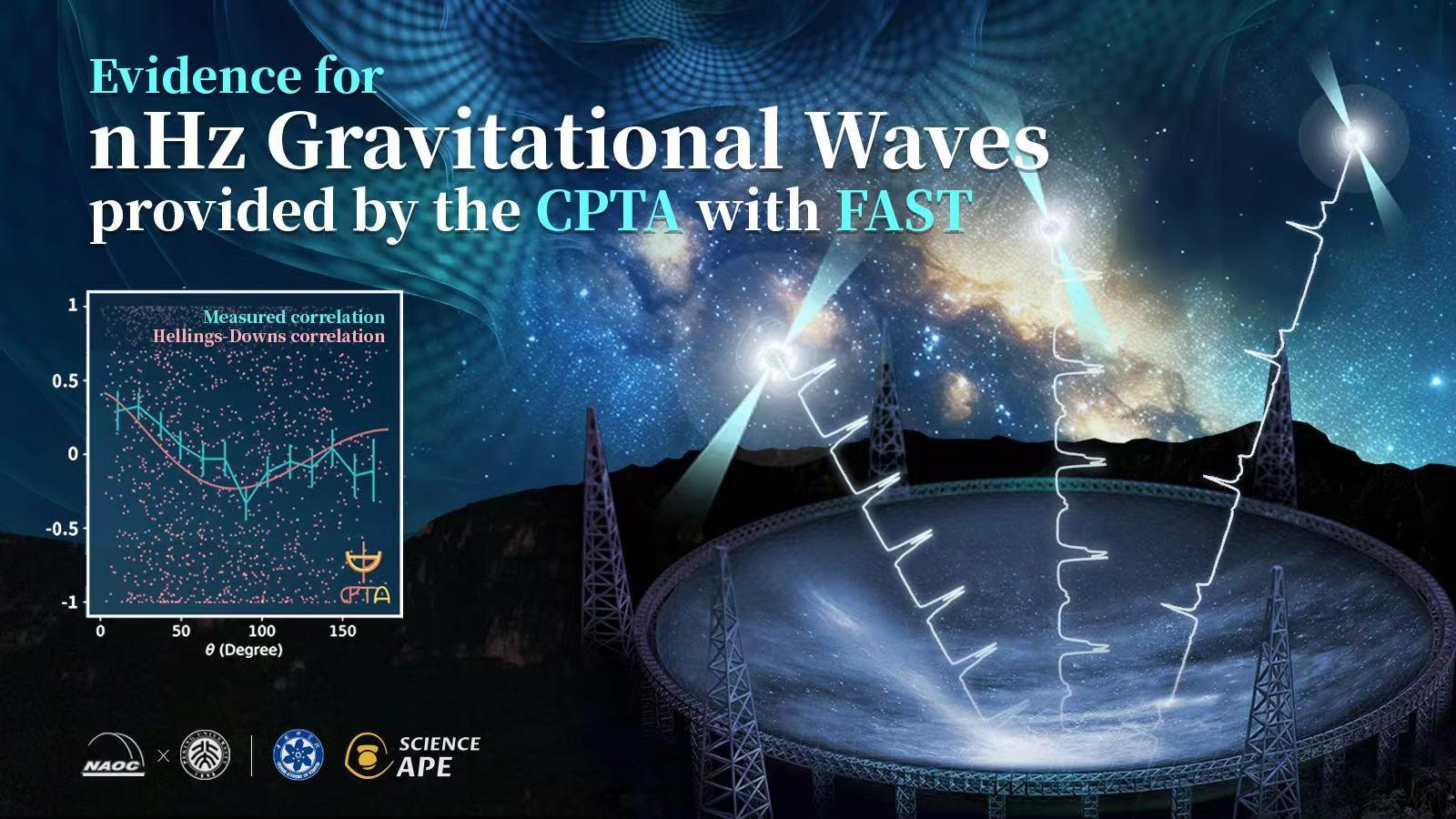Peking University, June 29, 2023: A group of Chinese scientists has recently found key evidence for the existence of nanohertz gravitational waves, marking a new era in nanohertz gravitational wave research. The research was based on pulsar timing observations carried out with the Five-hundred-meter Aperture Spherical Telescope (FAST).
The research was conducted by the Chinese Pulsar Timing Array (CPTA) collaboration. Researchers (Prof. Kejia Lee, Post-Doc. Siyuan Chen, PhD students Jiangwei Xu, and Zihan Xue) from Department of Astronomy School of Physics and Kavli Institute of Astronomy and Astrophysics of Peking University played vital roles in the collaboration. Their findings were published online in the academic journal Research in Astronomy and Astrophysics (RAA).

Figure 1: CPTA found the key evidence of nHz GW, the quadrupole correlation in pulsar timing residual is found with statistical significance of 4.6 Sigma corresponding to the false positive rate of two in a million.
Accelerations of massive objects disturb the surrounding space-time and produce the "ripples", or gravitational waves. The detection of nanohertz gravitational waves will help astronomers understand the formation of universe structures, and investigate the growth, evolution, and merger of supermassive black holes, the most massive celestial objects in the Universe. It will also help physicists gain insights into the fundamental physical laws of space-time. The CPTA collaboration used FAST to conduct long-term systematic monitoring of 57 millisecond pulsars. These millisecond pulsars form a Galactic-scale gravitational wave detector sensitive to the nanohertz gravitational waves. Based on data collected via FAST that spanned 3 years and 5 months, the CPTA team found evidence for the quadrupole correlation signatures compatible with the prediction of nanohertz gravitational waves at a 4.6 sigma statistical confidence level (false alarm probability of two of a million).
The gravitational wave signals are extremely weak, but they directly probe the masses that do not emit light in the universe. Opening up the cosmic observation window for gravitational waves has been one of the key goals that astronomers have been pursuing for a long time. Between the 1970s and 1980s, the existence of gravitational waves was indirectly confirmed by observing the orbital changes of pulsar binary systems, which led to the 1993 Nobel Prize in Physics for Hulse and Taylor. In 2016, the Laser Interferometer Gravitational-Wave Observatory (LIGO) announced the detection of gravitational waves from the merger of stellar-mass binary black holes in the 100-Hz frequency band, and soon won the 2017 Nobel Prize in Physics. More massive objects produce gravitational waves with lower frequencies. For example, the most massive celestial body in the universe, the supermassive black hole binaries (100 million to 100 billion times the solar mass) in the center of the galaxies mainly generate gravitational waves in the nanohertz band, and the corresponding signal time scale is from years to decades. In this frequency band, there are also gravitational wave contributions from early universe processes and exotic objects such as cosmic strings. Similar to LIGO, PTA is a direct GW detection method, where LIGO measures the phase of laser to detect GW and PTA measures the phase of pulsar rotation.
Taking advantage of FAST’s high sensitivity, the CPTA research team has monitored 57 millisecond pulsars with regular cadence for 41 months. The team found key evidence for quadrupole correlation signatures compatible with the prediction of nanohertz gravitational waves at a 4.6-sigma statistical confidence level (with a false alarm probability of two in a million).
The team used independently developed data analysis software and data processing algorithms to achieve its breakthrough on the same time as other international groups. Independent data processing pipelines produced compatible results.
The time span of CPTA data set is much shorter than the time spent by other telescopes to detect gravitational waves. However, due to the high sensitivity of FAST telescope, in just 3.5 years the CPTA achieved similar sensitivity compared to other PTAs. Future observations will soon extend the span of CPTA data and help in identifying the astrophysical sources or sources of current signal.
Objects of greater mass produce gravitational waves of lower frequency. For example, the most massive celestial body in the universe, the supermassive black hole binaries (with 100 million to 100 billion times the solar mass) in the center of galaxies, mainly generate gravitational waves in the nanohertz band, with corresponding signal time scales from years to decades. This frequency band also includes gravitational wave contributions from processes of the early Universe as well as exotic objects such as cosmic strings.
Using nanohertz gravitational waves in cosmic observation is thus hugely important in studying key problems in contemporary astrophysics such as supermassive black holes, the history of galaxy mergers, and the formation of large-scale structures in the Universe.
The detection of nanohertz gravitational waves is very challenging, though, due to their extremely low frequency, where the corresponding period can be as long as several years and wavelengths up to several light-years. So far, long-term timing observation of millisecond pulsars with extreme rotational stability is the only known method for effectively detecting nanohertz gravitational waves.
Hunting for these waves is one of the major focuses of present-day physics and astronomy. Regional pulsar timing array collaborations, including the North American Nanohertz Observatory for Gravitational Waves (NANOGrav), the European Pulsar Timing Array (EPTA), and the Australian Parkes Pulsar Timing Array (PPTA), have been collecting pulsar timing data for more than 20 years, with the aim of detecting nanohertz gravitational waves. Recently, several new regional collaborations have also joined this field, including CPTA, the India Pulsar Timing Array (InPTA), and the South Africa Pulsar Timing Array (SAPTA). NANOGrav, EPTA, and PPTA will announce similar results compatible to the current CPTA findings at the same day.The detection sensitivity of pulsar timing arrays to nanohertz gravitational waves strongly depends on the observational time span—that is, sensitivity grows rapidly with the increase in observational time span.
In the future, these regional collaborations will promote international pulsar timing array collaboration and expand exploration of the Universe through nanohertz gravitational wave observations.
Paper: https://iopscience.iop.org/article/10.1088/1674-4527/acdfa5
Source: KIAA
